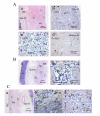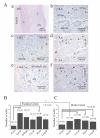Regional Distribution of Interstitial Cells of Cajal (ICC) in Human Stomach
- PMID: 21165331
- PMCID: PMC2997418
- DOI: 10.4196/kjpp.2010.14.5.317
Regional Distribution of Interstitial Cells of Cajal (ICC) in Human Stomach
Abstract
We elucidated the distribution of interstitial cells of Cajal (ICC) in human stomach, using cryosection and c-Kit immunohistochemistry to identify c-Kit positive ICC. Before c-Kit staining, we routinely used hematoxylin and eosin (HE) staining to identify every structure of human stomach, from mucosa to longitudinal muscle. HE staining revealed that the fundus greater curvature (GC) had prominent oblique muscle layer, and c-Kit immunostaining c-Kit positive ICC cells were found to have typical morphology of dense fusiform cell body with multiple processes protruding from the central cell body. In particular, we could observe dense processes and ramifications of ICC in myenteric area and longitudinal muscle layer of corpus GC. Interestingly, c-Kit positive ICC-like cells which had morphology very similar to ICC were found in gastric mucosa. We could not find any significant difference in the distribution of ICC between fundus and corpus, except for submucosa where the density of ICC was much higher in gastric fundus than corpus. Furthermore, there was no significant difference in the density of ICC between each area of fundus and corpus, except for muscularis mucosa. Finally, we also found similar distribution of ICC in normal and cancerous tissue obtained from a patient who underwent pancreotomy and gastrectomy. In conclusion, ICC was found ubiquitously in human stomach and the density of ICC was significantly lower in the muscularis mucosa of both fundus/corpus and higher in the submucosa of gastric fundus than corpus.
Keywords: Corpus; Fundus; Greater and Lesser curvature; Human stomach; Interstitial cells of Cajal (ICC); c-Kit.
Figures






References
-
- Cajal SR. Histologie du système nerveux de l'homme et des vertébrés. 2nd ed. Paris: Maloine; 1911. pp. 891–942.
-
- Faussone-Pellegrini MS, Cortesini C. Ultrastructural features and localization of the interstitial cells of Cajal in the smooth muscle coat of human esophagus. J Submicrosc Cytol. 1985;17:187–197. - PubMed
-
- Hagger R, Gharaie S, Finlayson C, Kumar D. Regional and transmural density of interstitial cells of Cajal in human colon and rectum. Am J Physiol. 1998;275:G1309–G1316. - PubMed
-
- Romert P, Mikkelsen HB. c-Kit immunoreactive cells of Cajal in the human small and large intestine. Histochem Cell Biol. 1998;109:195–202. - PubMed
LinkOut - more resources
Full Text Sources
Miscellaneous

